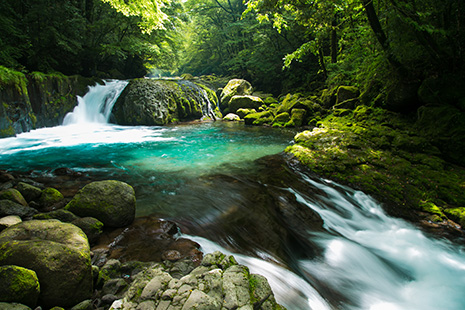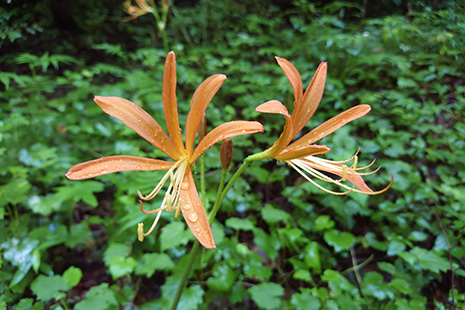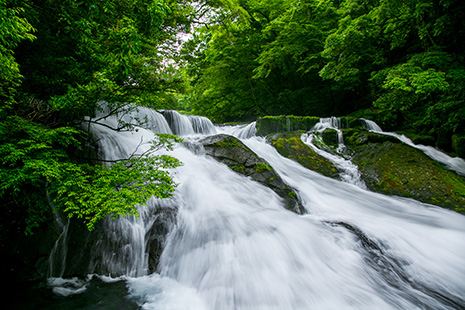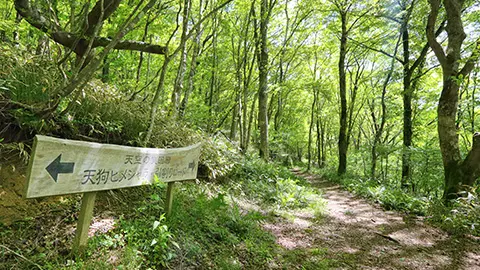VOL.192 MAY 2024
JAPAN’S HEALING FORESTS (PART 1)
The Kikuchi Gorge: Where Primeval and Clear Streams Meet

The mountain streams of Kikuchi Gorge are cool even in midsummer.
Photo: Kikuchi City

Rapids of different sizes can be seen in the gorge.
Photo: Kikuchi City
The Kikuchi Gorge is adorned with forests of natural broad-leaved trees such as zelkova, maple, and oak, alongside underground subterranean waters* flowing from the outer rim of Mount Aso, creating a landscape rich in diversity. Here, we explore its charm and the various ways to enjoy it.
Kyushu, in the southwest of the Japanese archipelago, is home to a volcanic group referred to as Mount Aso, near its central area. Inside the caldera**, one of the world’s largest (approximately 17 km east to west and 25 km north to south), lies a group of central volcanic cones, primarily including the five peaks of Mount Aso***. Together, these formations are collectively known as Mount Aso. The mountains surrounding the caldera are known as the outer rim of Mount Aso, stretching approximately 130km around. In the northwest part of the outer rim, there is a forested area covering around 1,192 hectares, known as Kikuchi Gorge.
It is a renowned location selected as one of the 100 best forest bathing spots, 100 best water sources, and 100 best waterfalls in Japan. Here, we learn about the charm of Kikuchi Gorge from Maejima Takeshi who works for Kikuchi City in Kumamoto Prefecture.
“Kikuchi Gorge boasts primeval forests, including broad-leaved trees and the source of the Kikuchi River. One of its notable features is the emergence of underground waters flowing from the outer rim of Mount Aso, forming a diverse array of rapids, pools, and waterfalls.” He continues, “The changing seasons and rich nature in the gorge create stunning views said to embody the epitome of beauty, offering a serene sanctuary where nature's splendor truly soothes the soul.”
Visitors can enjoy the sight of fresh young leaves in spring to early summer, and vibrant autumn foliage in the fall, experiencing the changing beauty of the forest throughout the seasons. Even at the height of Japan's hot and humid summer, you can feel the coolness in the gorge.
“Even in the summer, the stream’s water temperature stays cool at 13°C, while the river breeze and shaded areas create a refreshing, cool atmosphere. This makes it a popular destination for those seeking relief from the heat and a tranquil retreat,” explains Maejima.
To fully enjoy the forest, visitors are recommended to take a relaxing walk along the approximately 1-kilometer ‘Iyashi Course’ (‘iyashi’ translates as ‘healing’ in English), which takes about 40 minutes for a round trip from the Kikuchi Valley Visitor Center near the gorge entrance.
“This course offers a leisurely walk through the forest while enjoying the cobalt blue streams. The main highlight, Reimei (‘dawn’) Falls, is one of the most popular photography spots within the gorge. Especially in early summer, when the water volume is high, you can enjoy the water flowing down from large rocks.”

Reimei Falls is a highly popular photo spot.
Photo: Kikuchi City

Beautiful red heart lily flowers bloom at Ryugabuchi in the gorge.
Photo: Kikuchi City
Visitors can also enjoy the breathtaking sights of cascading waters at places such as Tengu Falls**** and Ryugabuchi, Pool (‘dragon’s pool’) experiencing the ever-changing beauty of the streams. In late July, many people visit the area around Ryugabuchi to see the beautiful red heart lily flowers in bloom. For people coming from overseas, a course that runs deep into the primeval forest is also popular ‘Mankitsu Course’ (‘mankitsu’ translates as ‘fully satisfying’ in English).

Yonjusanman Falls can be seen on the ‘Mankitsu Course’
Photo: Kikuchi City
“The ‘Mankitsu Course’ takes approximately 1 hour and 20 minutes to complete, leading visitors further into the depths of the forest. The impressive Yonjusanman (‘four hundred and thirty thousand’) Falls and Tengu Falls, among others, within the forest, showcase the vigorous splendor of nature's pure waters, creating an unforgettable sight. I also recommend taking a break on the wooden benches at the Hirogawara rest area located at the halfway point of the trail. Simply closing your eyes and listening to the sound of the river can instantly lift your spirits,” comments Maejima. “At the visitor center located at the entrance of the gorge, you can find specialty dishes like grilled mountain trout and light snacks available for purchase. After a walk, many visitors enjoy a meal while taking in the beauty of the gorge. If you get the chance, we’d love for you to stay a while and truly take in the experience.”
* Water that seeps into the ground easily and flows beneath the surface
** Calderas, often seen in volcanic regions, are depressions with diameters exceeding one kilometer, many of which are formed by the collapse of the ground. The bottom of the depression is called the caldera floor, while the surrounding elevated areas are known as the outer rim.
*** The collective name for the five central peaks of Mount Aso. From east to west, these are: Neko-dake (1,433 meters), Taka-dake (1,592 meters), Naka-dake (1,506 meters), Eboshi-dake (1,337 meters), and Kishima-dake (1,326 meters).
**** Tengu are goblin-like creatures believed to dwell in mountainous areas and are associated with supernatural powers, martial arts, and wisdom.
By Morohashi Kumiko
Photo: Kikuchi City

